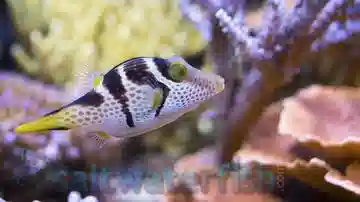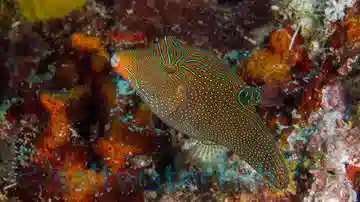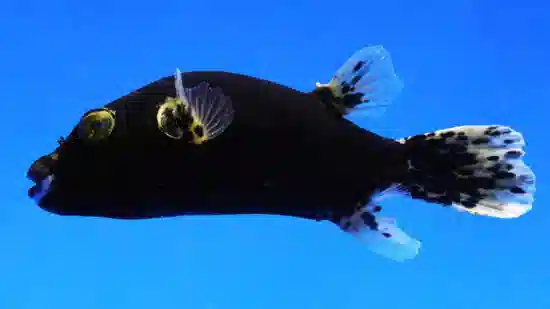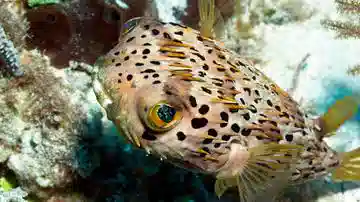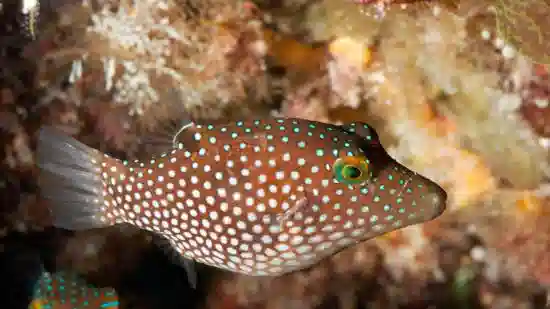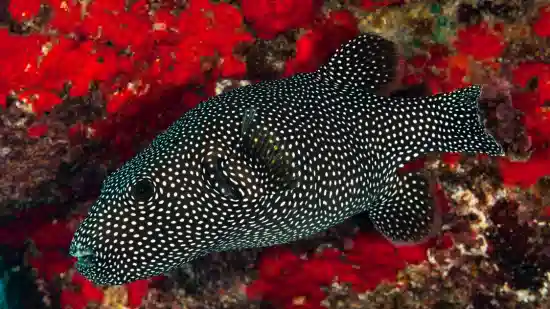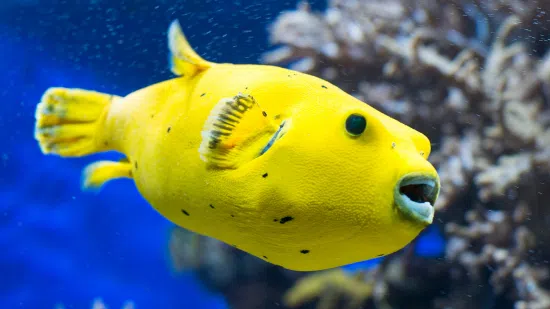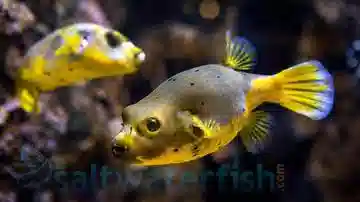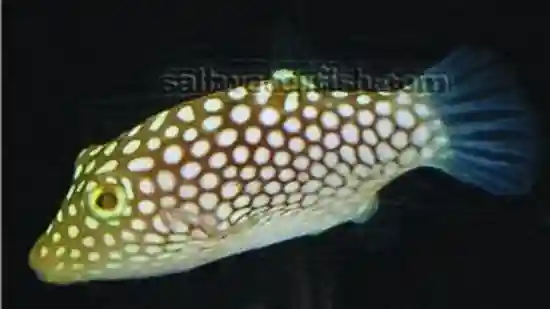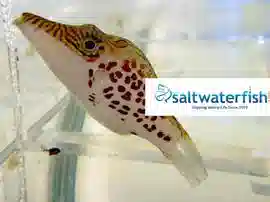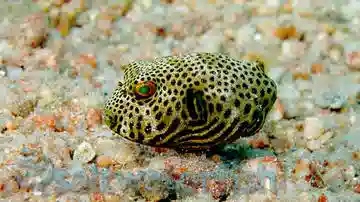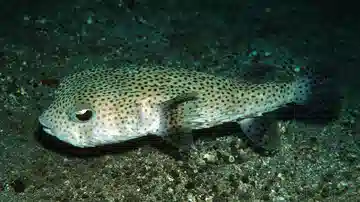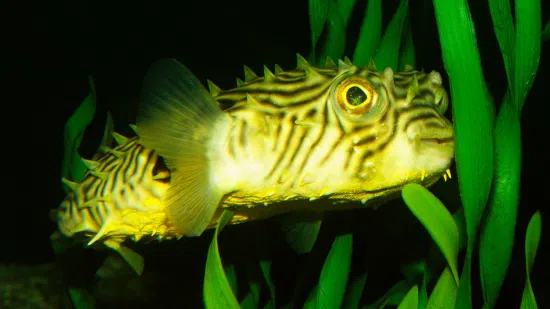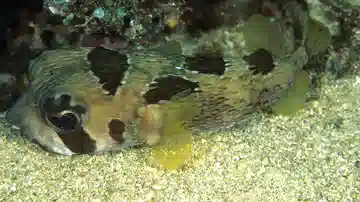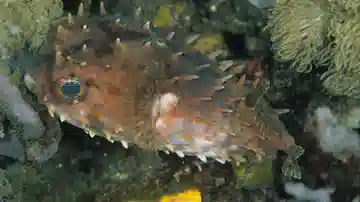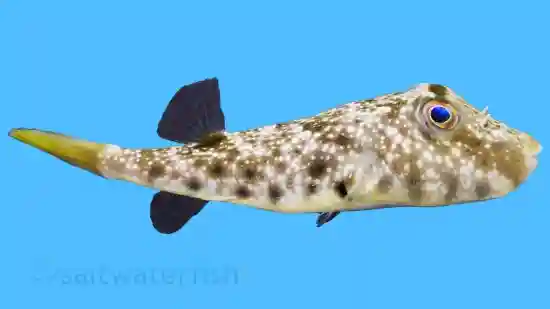Puffers In Saltwater Aquariums: FAQ
Saltwater puffer fish are among the most charming and intelligent marine species you can keep, famous for their curious nature and expressive faces. Their diet is both critical and fascinating, puffers are carnivores with specialized beak-like teeth that grow continuously, so they need hard-shelled foods to keep those teeth trimmed naturally.
In the wild:
Puffers spend much of their time foraging over reef rubble, breaking apart shells with remarkable bite force. Field studies have documented Arothron species feeding nocturnally on crabs, mollusks, and sea urchins, controlling populations that would otherwise overgraze corals (Hobson, 1974).
In the aquarium:
Their diet should mimic this diversity. The best foods for saltwater puffers include:
Hard-shelled items: Clams on the half shell, mussels, cockles, or crab legs to help wear down their teeth.
Meaty frozen foods: Mysis shrimp, krill, squid, and chopped shrimp for high protein intake.
Occasional live foods: Snails or small hermit crabs to stimulate natural hunting behavior.
High-quality pellets: Carnivore formulas supplement nutrition between feedings.
Feeding should occur once daily for juveniles and 3–4 times per week for adults. Overfeeding can foul water quickly, so remove uneaten food promptly.
One Saltwaterfish.com reviewer of the Blue Spot Puffer shared: “Great fish. I have had mine for a year. Eats out of my hand. Beautiful with corals.”
Pro tips:
Alternate hard and soft foods to balance nutrition and dental care.
Avoid feeding exclusively soft foods like shrimp, which can cause overgrown teeth.
- Supplement with marine vitamins to enhance color and immunity.
Bottom line:
Saltwater puffer fish thrive on a varied diet rich in meaty and shelled foods. Providing crunchy options like clams or crab legs keeps their teeth healthy and behavior natural. Feed with care, and your puffer will reward you with years of personality and charm, backed by Saltwaterfish.com’s trusted 8-Day Live Guarantee.
Saltwater puffer fish come in a wide range of sizes, from compact species perfect for moderate aquariums to large, showpiece fish that demand spacious marine systems. Understanding their growth potential is crucial before purchase, as puffers are long-lived and fast-growing when properly cared for.
Typical size ranges of popular saltwater puffers:
Valentini (Saddle) Puffer (Canthigaster valentini) – 3–4 inches. A small, hardy puffer ideal for tanks 30 gallons or larger.
*Blue Spot Puffer (Canthigaster solandri) – 3–4 inches. Reef-safe with caution and full of personality.
*Dogface Puffer (Arothron nigropunctatus) – 10–12 inches. Requires at least a 125-gallon aquarium.
*Porcupine Puffer (Diodon holocanthus) – 12–15 inches. Known for its endearing expressions and large adult size.
*Stars and Stripes Puffer (Arothron hispidus) – Can exceed 18 inches in captivity. Best for expert aquarists with large systems (180+ gallons).
Wild studies confirm that Arothron hispidus regularly surpasses 40 cm (16 in) in length, with A. stellatus reaching up to 60 cm in mature reef habitats (Randall et al., 1998). Captive puffers with ample space and a natural diet often approach their wild size and can live 10–15 years.
One Saltwaterfish.com reviewer of the Stars and Stripes Puffer shared: “Stars and Stripes Puffer Great addition to 28g Biocube reef tank. Very healthy and active. Add great color to coral tank.”
Pro tips for managing puffer growth:
Plan for the adult size before purchase.
Offer ample swimming space and powerful filtration for larger species.
Rotate meaty and shelled foods to support healthy growth and dental wear.
Bottom line:
Saltwater puffer fish can grow anywhere from 3 inches (for smaller Canthigaster species) to over 18 inches (for large Arothron puffers). Knowing your species’ adult size ensures you can provide the proper environment for long-term health. Explore our full saltwater puffer selection today, each backed by our trusted 8-Day Live Guarantee for complete peace of mind.
Puffer fish are among the most entertaining and intelligent marine species, but most are not reef safe. Their strong, beak-like teeth and natural feeding instincts make them opportunistic predators of invertebrates, which can lead to problems in coral tanks.
Reef-safe (with caution) species:
Smaller Canthigaster species, often called “Tobies,” are the best options for mixed reef tanks.
Valentini (Saddle) Puffer (Canthigaster valentini) – Typically reef safe with caution. May nip at small snails or hermits but rarely bothers coral when well-fed.
*Blue Spot (Sharpnose) Puffer (Canthigaster solandri) – Colorful and active, often safe in large, well-fed reef tanks.
Not reef safe species:
Larger puffers such as Arothron and Diodon species are best kept in fish-only systems.
*Dogface Puffer (Arothron nigropunctatus) – Eats crustaceans, snails, and shrimp.
*Porcupine Puffer (Diodon holocanthus) – Known to nip at invertebrates and occasionally corals.
*Stars and Stripes Puffer (Arothron hispidus) – A powerful predator of hard-shelled reef animals.
One Saltwaterfish.com reviewer of the Yellowbelly Dogface shared: “The Yellowbelly Dogface \- Central Pacific was shipped extremely well, and it was a perfect addition to my reef tank. I acclimated according to the instructions, and I have had no problems with any of the fish I have received. What more can you ask for? Cheaper then my local fish store and it was delivered to my front door the next day.”
Pro tips for keeping puffers in reefs:
Choose smaller Canthigaster species only.
Keep them well-fed with shelled foods to reduce nipping behavior.
Monitor interactions during the first few weeks after introduction.
Bottom line:
Most large puffer fish are not reef safe, but smaller Canthigaster puffers like the Valentini and Blue Spot can coexist peacefully in reef tanks with proper care. By choosing the right species and maintaining a consistent feeding routine, you can enjoy their color and charm without coral damage. Explore our saltwater puffer collection today, backed by Saltwaterfish.com’s trusted 8-Day Live Guarantee for confidence.
Yes, puffer fish require above-average filtration and stable conditions to thrive. Whether you keep a small Canthigaster species in a mixed reef or a large Arothron in a fish-only setup, proper filtration and tank maintenance are essential for long-term success. Puffers are messy eaters with strong jaws that crush shellfish and crustaceans, leaving behind fragments that can quickly impact water quality if not managed correctly. Because puffers lack protective scales and a complete gill cover, they absorb environmental toxins more readily and are particularly vulnerable to copper and ammonia.
Filtration requirements for puffer tanks:
High-capacity protein skimmer: Puffers produce more organic waste than most fish. A powerful skimmer removes uneaten food and dissolved organics efficiently.
Mechanical filtration: Use fine filter socks or pads to trap debris from crushed shellfish and clean them frequently.
Biological filtration: Live rock or a refugium supports beneficial bacteria to handle ammonia and nitrite.
Strong water flow: Adequate circulation prevents detritus buildup and ensures oxygen-rich conditions.
One Saltwaterfish.com reviewer of the Caribbean Sharpnose Puffer shared: “Love this Caribbean Sharpnose Puffer\! He is so beautiful and such an interesting personality\! He doesn't bother anyone and has actually become friends with our yellow wrasse\! They swim attached at the hip looking for food\! He is a very mellow swimmer who loves swimming through the rock work to find new caves. He is a little hard to feed when competing with quicker eaters, I let a couple pellets sink in front of him and sink a few spirulina flakes\! I highly recommend him, he is sweet, beautiful, and easy\!”
Pro care tips for puffers:
Perform 15–20% water changes weekly to maintain water quality.
Avoid copper or harsh medications; puffers are highly sensitive.
Feed sparingly and remove uneaten food immediately.
Ensure tight lids, puffers are strong jumpers when startled.
Bottom line:
Puffer fish require strong, efficient filtration and consistent maintenance to stay healthy. Their messy eating habits and sensitivity to poor water conditions make stability key to success. With proper care and high-quality filtration, your puffer will thrive as a vibrant, personable centerpiece, backed by Saltwaterfish.com’s trusted 8-Day Live Guarantee.
Puffer fish are intelligent, curious, and full of personality, but they can also be territorial. Keeping multiple puffers together is possible, but it depends on the species, tank size, and individual temperament. Some species tolerate tankmates of similar size, while others view any puffer as competition.
General guidelines for housing multiple puffers:
Small species (e.g., Valentini or Blue Spot Puffers – Canthigaster spp.) – In tanks 75 gallons or larger with plenty of rockwork, multiple individuals may coexist peacefully if introduced carefully. Each should have its own territory with visual barriers.
*Large species (e.g., Dogface, Porcupine, or Stars and Stripes Puffers – Arothron spp.) – These fish are best kept singly. They are intelligent but territorial, especially toward other puffers.
Mixed setups: Avoid combining large and small species; the larger puffer’s curiosity often turns aggressive during feeding or space competition.
One Saltwaterfish.com reviewer of the Spotted Sharpnose Puffer shared: “Love love this fish. Glad I bought it. Peaceful, very inquisitive. It gets along with my other puffer (Valentini) and other fish in my fish only aquarium. Can highly recommend.”.
Pro tips for multiple puffer setups:
Only attempt multiples in tanks 125 gallons or larger with abundant hiding spots.
Introduce all puffers at the same time to reduce territorial aggression.
Monitor feeding closely, competition often triggers hostility.
Bottom line:
While some smaller Canthigaster* species may coexist in large, well-structured aquariums, most puffers are best kept individually. Their intelligence and territorial nature make them ideal as solitary showpieces. Explore our full puffer fish collection today, each protected by Saltwaterfish.com’s trusted 8-Day Live Guarantee for peace of mind.
Puffer fish are intelligent and curious marine animals, but their natural behavior can sometimes lead to fin-nipping or aggression toward tankmates. Because puffers have powerful beak-like teeth and a strong instinct to explore, they may “test bite” other fish, especially in smaller tanks or when underfed. With proper care and environment management, however, this behavior can be minimized or eliminated.
Common causes of nipping:
Hunger or boredom: Puffers need frequent, satisfying meals. If not provided with enough stimulation or hard foods to chew on, they may redirect that behavior toward tankmates.
Territorial instinct: Puffers often claim a favorite area of the tank, defending it against other mid-sized fish.
Incompatible species: Slow-moving or long-finned fish, such as lionfish or angelfish, are more likely to be targets.
Ways to prevent nipping:
Feed a varied diet: Include crunchy foods such as clams on the half shell, mussels, and crab legs. Hard foods help wear down teeth and satisfy natural foraging urges.
Provide space and hiding areas: Tanks of 75 gallons or larger (125+ for large species) with rockwork and caves reduce territorial tension.
Choose compatible tankmates: Fast, active species like wrasses, tangs, and clownfish coexist well. Avoid passive or flowy-finned fish.
Maintain a feeding routine: Consistent feeding times reduce food-related aggression and stress.
One Saltwaterfish.com reviewer of the Map Puffer shared: “I bought this Map Puffer here and to show you how hardy this guy is, he was the most active of 5 fish I had delivered when outside temp in MN was 21 degree out and bag water was at 68 degrees. All survived after 2 1/2 hr slow drip acclimation. He is a colorful little guy to watch darting around the tank. He is constantly on the move searching for food or detritus on the bottom as well as on reef rock. Likes to dart in and out of rock. He is getting much better at snagging Mysis shrimp I drop in before the other 6 fish hog it all, especially my Hamlet Indigo who gobbles everything that moves. A joy to watch.”.
Pro tips:
Feed puffers first at mealtime to limit competition.
Rearrange live rock occasionally to reset territories.
Avoid housing multiple large puffers in one tank.
Bottom line:
Puffer fish nipping is usually caused by hunger, boredom, or competition for space. By offering a proper diet, compatible tankmates, and a well-structured environment, you can enjoy your puffer’s personality without aggression. Explore our saltwater puffer collection today, backed by Saltwaterfish.com’s trusted 8-Day Live Guarantee for confidence.
Puffer fish are some of the most fascinating saltwater species due to their intelligence, personality, and unique appearance. However, they also have a well-earned reputation for snacking on crustaceans. Most puffers possess strong, continuously growing beak-like teeth designed for crushing the shells of crabs, snails, and shrimp in the wild. For this reason, very few can be considered completely “reef safe.” That said, some smaller species are much less likely to harm invertebrates, especially when kept well-fed and in spacious, balanced environments.
Puffer species least likely to eat shrimp or crabs:
Valentini (Saddle) Puffer (Canthigaster valentini) – Known as one of the most reef-compatible puffers. May occasionally pick at hermits or tiny shrimp but often coexists peacefully in mature tanks.
*Blue Spot (Sharpnose) Puffer (Canthigaster solandri) – Curious yet generally gentle; rarely bothers larger shrimp or crabs when provided with regular, satisfying feedings.
*Spotted Toby (Canthigaster jactator) – Small, colorful, and less destructive than larger Arothron puffers.
One Saltwaterfish.com reviewer of the Star Puffer shared: “This is a great Star Puffer who showed up healthy and happy. He was shy at first in my quarantine tank but after moving him over to the main tank he has been quite the showman. Beautiful fish to add to a reef tank.”.
Pro tips for keeping puffers with invertebrates:
Feed a variety of meaty foods (mussels, clams, shrimp) to reduce hunting behavior.
Provide plenty of live rock and caves for invertebrates to retreat.
Introduce shrimp or crabs before adding the puffer to establish territory.
Bottom line:
While most puffer fish have a natural instinct to eat shrimp and crabs, smaller Canthigaster* species, like the Valentini, Blue Spot, and Spotted Toby Puffers, are less likely to cause trouble in well-managed reef tanks. With stable conditions and regular feedings, these mini puffers offer the charm of their larger cousins without the risk. Explore our saltwater puffer collection today, each protected by Saltwaterfish.com’s trusted 8-Day Live Guarantee.
Puffer fish are intelligent and engaging marine species, but they are also sensitive to stress, poor water quality, and rapid environmental changes. Because puffers lack traditional scales and have thinner skin than most saltwater fish, they can be more vulnerable to parasites, bacterial infections, and water chemistry fluctuations. Recognizing early signs of illness is crucial to protecting both your puffer and the stability of your aquarium.
Common signs of illness in puffer fish:
Loss of appetite: Puffers are enthusiastic eaters. A sudden refusal to eat or spitting food indicates possible infection or stress.
Rapid breathing or gasping: Often linked to poor water quality or gill irritation from elevated ammonia or nitrite levels.
White spots or fuzzy patches: May signal marine ich (Cryptocaryon irritans) or fungal infections.
Cloudy eyes or fin erosion: Typically caused by bacterial infections or poor water conditions.
Lethargy or hiding: Puffers normally stay active and alert. Unusual inactivity is a warning sign.
Bloating or abnormal swelling: Can result from internal parasites or overinflation due to stress.
One Saltwaterfish.com reviewer of the Long-Spine Porcupine Puffer shared: “Cute little guy. About 3". Was a bit shy at first, but appears hearty and is starting to eat well. Not interested in my snails yet, but I'm sure that will change.”.
Pro tips for prevention and care:
Maintain ammonia and nitrite at zero; keep nitrates below 10 ppm.
Perform weekly 15–20% water changes to preserve water quality.
Avoid copper-based medications; puffers are extremely sensitive to copper.
Quarantine new arrivals before adding them to your display tank.
Bottom line:
Puffer fish show early signs of illness through changes in appetite, breathing, and behavior. Regular monitoring, excellent water quality, and gentle care help prevent most diseases. With proper maintenance and observation, your puffer can stay healthy and active for years. Browse our saltwater puffer collection today, each backed by Saltwaterfish.com’s trusted 8-Day Live Guarantee for confidence.
Puffer fish have continuously growing teeth that form a beak-like plate used to crush hard-shelled prey in the wild. Without proper foods to wear them down, their teeth can overgrow, making it difficult to eat and sometimes requiring manual trimming. Feeding the right diet is the simplest and most natural way to maintain their dental health.
Best foods for puffer dental health:
Clams on the half shell: A natural staple that helps grind teeth while providing excellent nutrition.
Mussels, cockles, and oysters: Hard shells encourage chewing and maintain proper tooth length.
Crab legs and shrimp with shell: Offer both protein and necessary resistance for natural wear.
Snails (live or frozen): Great for smaller puffers like the Valentini (Canthigaster valentini) or Blue Spot (Canthigaster solandri).
High-quality carnivore diets: Can be offered as supplemental feedings but should not replace shelled foods.
In the wild, pufferfish spend much of their day crushing shelled invertebrates. Studies show that their continuously growing dental plates are self-regulated through this durophagous feeding behavior (Motta,1988)
One Saltwaterfish.com reviewer of the Valentini Puffer shared: “Has acclimated great.”
Pro tips for feeding:
Alternate hard and soft foods for balanced nutrition.
Avoid feeding only soft foods like mysis or squid, which can lead to tooth overgrowth.
Remove uneaten shells promptly to maintain water quality.
Bottom line:
The best foods for keeping puffer fish teeth healthy are crunchy, shelled items like clams, mussels, snails, and crab legs. These mimic their natural diet, promote proper wear, and keep their teeth strong. With consistent feeding and care, your puffer will thrive as a healthy, active showpiece. Shop our saltwater puffer collection today, backed by Saltwaterfish.com’s trusted 8-Day Live Guarantee.
Puffer fish are among the most fascinating and distinctive marine species in the ocean, admired for their intelligence, curiosity, and unmistakable charm. Their combination of defensive adaptations, expressive personalities, and specialized anatomy sets them apart from almost every other saltwater fish kept in aquariums.
Unique traits that make puffer fish stand out:
Inflation defense mechanism: When threatened, puffers can rapidly inflate their bodies with water or air, making themselves appear larger and harder to swallow. This unique defense behavior is one of the most recognizable in the marine world.
Beak-like teeth: Unlike other fish, puffers’ teeth grow continuously and fuse into a beak used to crush hard-shelled prey such as snails, crabs, and clams.
High intelligence and personality: Puffers are known for recognizing their owners, following movement outside the tank, and even begging for food, behaviors rarely seen in other reef fish.
Toxin defense in some species: Certain species, especially those in the Arothron genus, can produce tetrodotoxin, a natural chemical defense that deters predators in the wild.
Lack of scales: Puffers have thick, leathery skin rather than scales, giving them a smooth appearance but making them more sensitive to poor water conditions and copper-based medications.
One Saltwaterfish.com reviewer of the Blue Spot Puffer shared: “Beautiful fish who has fit well in my new FOWLR tank. Very pretty\!”.
Pro care tips:
Provide a large tank with strong filtration to handle their messy eating habits.
Feed a balanced diet with hard-shelled foods to maintain dental health.
Avoid copper-based treatments; puffers are sensitive to metals and harsh medications.
Bottom line:
Puffer fish are unique for their intelligence, ability to inflate, and powerful beak-like teeth, traits that make them both fascinating and rewarding to keep. Their personality and charm turn any aquarium into a dynamic display of marine life. Explore our saltwater puffer collection today, each backed by Saltwaterfish.com’s trusted 8-Day Live Guarantee.
The ability to “puff up” is one of the most recognizable and fascinating traits of puffer fish. This unique behavior is a defensive mechanism developed to deter predators and increase survival in the wild. When threatened or startled, a puffer rapidly gulps water (or sometimes air if removed from the tank), expanding its body to two or three times its normal size. This makes it appear much larger and more intimidating, often too big for a predator to swallow.
How the puffing mechanism works:
When a puffer senses danger, it uses a specialized elastic stomach to intake large volumes of water in seconds. The expansion forces its spines (in some species) to stand erect and stiff, creating an almost unmanageable shape for predators. Once the threat passes, the puffer slowly expels the water and returns to its normal size.
Why puffers inflate in aquariums:
Startle response: Sudden movements, loud noises, or aggressive tankmates can trigger puffing.
Handling stress: Puffers may inflate if netted or removed from the water. Always keep them submerged to prevent swallowing air, which is harder for them to expel.
Environmental stress: Rapid changes in temperature, salinity, or poor water quality can cause puffers to feel threatened and inflate defensively.
Scientific research confirms that inflation is a complex physiological reflex involving rapid water intake, skeletal flexibility, and muscle coordination (Brainerd, 1994). Later biomechanical analyses show it’s a costly, stress-inducing defense, not a behavior to encourage. If a puffer inflates often, check for aggression, water instability, or handling stress. It’s their way of saying something’s wrong.
One Saltwaterfish.com reviewer of the Spotted Sharpnose Puffer shared: “So far so good, Its been a week. He arrived alive and is eating good. About to start my qt on him next w/e. Feeding him Roe, and krill twice a day. Puffer is so tiny...”.
Pro tips for care:
Avoid startling or chasing your puffer.
Never force a puffer to inflate for entertainment, it causes stress and potential injury.
- Maintain calm surroundings and stable tank conditions.
Bottom line:
Saltwater puffer fish puff up as a natural defense mechanism to appear larger and ward off predators. In captivity, it usually happens due to stress or sudden disturbances. With gentle handling and a stable environment, puffers rarely need to use this behavior and will remain relaxed, healthy, and full of personality. Explore our saltwater puffer collection today, each backed by Saltwaterfish.com’s trusted 8-Day Live Guarantee.
Puffer fish are known for their charming personalities and comical ability to inflate when threatened, but they also have a reputation for being poisonous. The truth depends on the species and environment. While many wild puffer species contain tetrodotoxin, a powerful natural defense chemical, aquarium-raised puffers are not dangerous and cannot “infect” your tank.
Toxicity in the wild vs. aquariums:
In nature, puffers accumulate tetrodotoxin through their diet, ingesting toxic bacteria and algae that produce the compound. The toxin is concentrated in organs such as the liver and skin, deterring predators from eating them. Research by Noguchi & Arakawa (2008) shows that puffers raised in controlled, toxin-free environments, like aquariums, do not develop or store tetrodotoxin, making them completely safe for home tanks.
Can puffer fish release toxins into the water?
No. Saltwater puffers (family Tetraodontidae) do not release toxins into the water when stressed or handled. This myth is often confused with boxfish and cowfish (family Ostraciidae), which can secrete toxins when severely stressed. Even if a puffer dies in your aquarium, it will not poison the tank or harm other fish.
One Saltwaterfish.com reviewer of the Valentini Puffer shared: “Stunning.”
Pro tips for keeping puffers safe and healthy:
Always buy from reputable sources that raise puffers in toxin-free conditions.
Avoid provoking puffers to inflate; it causes stress.
Maintain clean, stable water quality to prevent illness or stress reactions.
Bottom line:
While wild puffer fish can contain tetrodotoxin, aquarium-raised puffers are not poisonous and cannot infect or contaminate your tank. They do not release toxins in captivity and are completely safe to keep with other marine fish. With proper care and sourcing, puffers make fascinating, personable additions to any saltwater aquarium. Explore our saltwater puffer collection today, backed by Saltwaterfish.com’s trusted 8-Day Live Guarantee.
Puffer fish are beloved for their playful nature, expressive faces, and remarkable intelligence, but reef aquarists must choose species carefully. While many puffers have strong beak-like teeth used to crush crustaceans and mollusks, a few smaller varieties are considered “reef safe with caution” and can live successfully in coral aquariums when properly cared for.
Best puffer fish for reef aquariums:
Valentini (Saddle) Puffer (Canthigaster valentini) – One of the most popular reef-compatible puffers. Small (3–4 inches) and active, it rarely harms coral if fed consistently.
*Blue Spot (Sharpnose) Puffer (Canthigaster solandri) – Hardy, colorful, and peaceful. Typically ignores corals and invertebrates when well-fed.
*Spotted Toby Puffer (Canthigaster jactator) – A smaller species ideal for mid-sized reef tanks. Enjoys exploring live rock and caves.
Puffers to avoid in reef tanks:
Larger puffers such as the Dogface Puffer (Arothron nigropunctatus), Porcupine Puffer (Diodon holocanthus), and Stars and Stripes Puffer (Arothron hispidus) are not reef safe. They naturally prey on invertebrates, snails, and clams, often damaging corals in the process.
One Saltwaterfish.com reviewer of the Long-Spine Porcupine Puffer shared: “Our little guy was about 4 inches when we got him about 3 years ago and doing well. He is about 8 inches now in a 180 gallon tank with a Hawaiian black trigger and a fox face.”.
Pro tips for keeping puffers in reef setups:
Keep puffers well-fed with a variety of meaty foods to reduce curiosity-nipping.
Provide at least 55 gallons and plenty of live rock for shelter.
Observe coral and invert behavior closely during the first few weeks.
Bottom line:
The best puffer fish for reef tanks are smaller Canthigaster species such as the Valentini, Blue Spot, and Spotted Toby Puffers. These miniature puffers combine bold color with a gentle temperament, making them ideal reef companions. With consistent feeding and stable conditions, they add lively personality to any reef aquarium. Explore our saltwater puffer collection today, each backed by Saltwaterfish.com’s trusted 8-Day Live Guarantee.
Puffer fish are some of the most intelligent and personable marine fish available, but not all species adapt equally well to aquarium life. The hardiest puffers are those that tolerate minor changes in water parameters, readily accept prepared foods, and thrive in stable, well-maintained tanks. These species are excellent choices for aquarists new to keeping puffers or looking for reliable, low-stress additions to their marine setups.
Hardiest saltwater puffers for home aquariums:
Valentini (Saddle) Puffer (Canthigaster valentini) – Compact (3–4”), colorful, and incredibly resilient. Adapts easily to new tanks and commonly thrives in mixed-reef environments when well-fed.
*Blue Spot (Sharpnose) Puffer (Canthigaster solandri) – Hardy and highly adaptable. Peaceful and active, this small species tolerates a range of tank conditions when kept in clean, stable water.
*Dogface Puffer (Arothron nigropunctatus) – Larger (10–12”), but renowned for being gentle, hardy, and full of personality. Ideal for fish-only setups.
*Porcupine Puffer (Diodon holocanthus) – A classic favorite known for friendliness and durability when housed in spacious, well-filtered systems.
One Saltwaterfish.com reviewer of the Whitebelly Puffer shared: “An awesome little beautiful Whitebelly Puffer who peacefully explores my large reef tank's caves. Almost always visible and active.”.
Pro tips for hardy puffers:
Maintain stable salinity (1.024–1.026) and temperature (76–78°F).
Feed a mixed diet including shelled foods to promote dental health.
Avoid copper treatments, puffers are sensitive to metals and harsh chemicals.
Bottom line:
The hardiest puffer fish for saltwater aquariums include the Valentini, Blue Spot, Dogface, and Porcupine Puffers. These species are adaptable, easy to feed, and exceptionally resilient, making them ideal for hobbyists at all experience levels. Explore our saltwater puffer collection today, each backed by Saltwaterfish.com’s trusted 8-Day Live Guarantee.
The Golden Puffer (Arothron meleagris), also known as the Guineafowl Puffer, is one of the most striking and charismatic saltwater fish available. Its bold coloration, curious personality, and dog-like intelligence make it a favorite among advanced aquarists. However, this species grows large and has specific care requirements that must be met to ensure long-term health and success.
Tank and environmental requirements:
Minimum tank size: 180 gallons or larger. Golden Puffers can grow up to 20 inches and require ample swimming space.
Aquascaping: Provide open areas for swimming and large caves or arches for resting. Avoid sharp rock edges that can damage their delicate skin.
Water conditions: Keep salinity at 1.024–1.026, pH between 8.1–8.4, and temperature stable at 76–78°F. Puffers are highly sensitive to ammonia and nitrite, so excellent filtration and regular water changes are essential.
Filtration: Use a strong protein skimmer and robust biological filtration. Golden Puffers are messy eaters that generate heavy waste loads.
Diet and feeding:
Golden Puffers are carnivores that feed on hard-shelled foods to keep their continuously growing teeth properly worn. Offer a varied diet of clams, mussels, crab legs, shrimp, squid, and high-quality frozen meaty foods several times per week.
One Saltwaterfish.com reviewer of the Golden Puffer shared: “The Golden Puffer are great fish. They acclimated very well. They are always out and swimming around. Their color changes under my lighting. Fun to watch.”.
Compatibility:
Golden Puffers are best kept singly. They may nip at slow-moving or smaller fish and will consume shrimp, snails, and other invertebrates. Suitable tankmates include larger, confident species such as triggers, groupers, and tangs in very spacious aquariums.
Pro tips for success:
Feed a mix of hard and soft meaty foods to prevent tooth overgrowth.
Maintain high water quality and perform frequent water changes.
- Provide plenty of hiding spaces to help reduce territorial stress.
Bottom line:
The Golden Puffer is a stunning and intelligent showpiece that thrives in large, well-filtered aquariums of 180 gallons or more. With stable water conditions, strong filtration, and a protein-rich diet, this fish will reward you with years of interaction and personality. Explore our Golden Puffer selection today, backed by Saltwaterfish.com’s trusted 8-Day Live Guarantee for peace of mind.
It may be tempting to see your puffer fish inflate, but intentionally causing this behavior is dangerous and highly stressful for the animal. Puffing up is a defense mechanism, not a playful act. In nature, puffers expand their elastic stomachs by rapidly swallowing water when threatened, making themselves appear larger and harder for predators to eat. In captivity, this response should only happen rarely and naturally when the fish feels frightened or startled.
Why puffers should never be forced to inflate:
Stress and exhaustion: Puffing requires significant energy and can cause extreme physiological stress, weakening your fish.
Air ingestion risk: When a puffer is removed from water, it can swallow air instead of water. Air is difficult for puffers to expel and may remain trapped, causing buoyancy issues or internal injury.
Potential health damage: Forcing a puffer to inflate repeatedly can lead to swim bladder problems, digestive distress, and even death.
Studies confirm that inflation is a defensive emergency behavior, not a harmless quirk. Brainerd (1994) showed that it involves specialized musculature and skeletal flexibility. Aquarium puffers should never be encouraged to puff for entertainment purposes.
One Saltwaterfish.com reviewer of the Freckled Grey Dogface Puffer shared: “Terribly cute\!\! He is appropriately named. I love bold fish and this one foots the bill. He eats just about anything and will even eat out of the long handled dispenser I put the frozen food in.”.
Pro tips for safe handling:
Never lift your puffer out of the water. If relocation is needed, transfer it gently underwater using a container.
Keep tank conditions stable to prevent stress-triggered puffing.
Avoid loud noises, sudden lights, or chasing movements near the tank.
Bottom line:
Never take a puffer fish out of the water to make it puff up. Inflation is a natural but stressful survival behavior, not a trick for human amusement. Keeping your puffer calm, well-fed, and secure ensures it remains healthy, happy, and interactive for years. Explore our saltwater puffer collection today, each backed by Saltwaterfish.com’s trusted 8-Day Live Guarantee for peace of mind.

